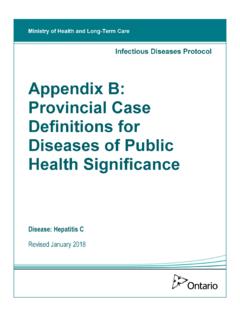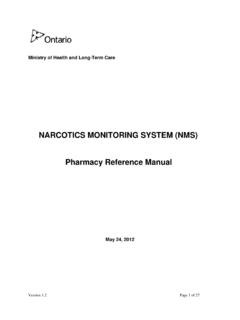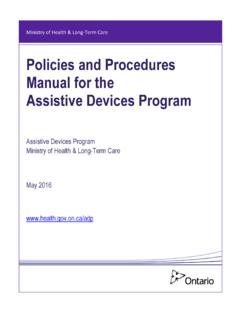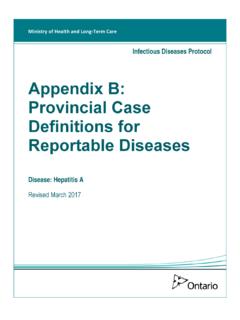Transcription of Appendix B: Provincial Case Definitions for …
1 Ministry of Health and Long-Term Care Infectious Diseases Protocol Appendix B: Provincial case Definitions for reportable Diseases Disease: Lyme Disease Revised March 2017 Health and Long-Term Care Lyme Disease Provincial Reporting Confirmed and probable cases of disease Type of Surveillance case -by- case case Classification Confirmed case Clinician-confirmed erythema migrans (EM) greater than 5 cm in diameter with a history of residence in, or visit to, a Lyme disease endemic area or risk area (see section , comments #1, #4 and #5).
2 OR Clinical evidence of Lyme disease (see section , comment #2) with laboratory confirmation by PCR or culture (see section , comment #3); OR Clinical evidence of Lyme disease with laboratory support by serological methods (see section , comment #3), and a history of residence in, or visit to, an endemic area or risk area (see section , comments #4 and #5). Probable case Clinical evidence of Lyme disease with laboratory support by serological methods (see section , comment #3), but with no history of residence in, or visit to an endemic area or risk area (see section , comments #4 and #5); OR Clinician-confirmed erythema migrans (EM) greater than 5 cm in diameter but with no history of residence in, or visit to an endemic area or risk area (see section , comments #1, #4 and #5).
3 Laboratory Evidence Laboratory Confirmation Any of the following will constitute a confirmed case of Lyme disease: Isolation of B. burgdorferi from an appropriate clinical specimen; 2 Health and Long-Term Care Positive nucleic acid amplification test (NAAT) for B. burgdorferi; and Serological evidence using the two-tier enzyme-linked immuno-sorbent assay (ELISA) and Western Blot testing using CPHLN/CDC based interpretation criteria. Approved/Validated Tests Standard culture for B. burgdorferi; Commercial B.
4 Burgdorferi Immunoglobulin M (IgM) and Immunoglobulin G (IgG) tests (ELISA and Western Blot); and NAAT for B. burgdorferi. Indications and Limitations Only serum samples are acceptable for serology. Initial negative serological tests in patients with skin lesions suggestive of EM should have testing repeated after 2 to 4 weeks, however if patients are treated during this time, subsequent testing may be negative. Sera that are screened negative for antibodies using an EIA should not be subjected to Western blot testing.
5 The possibility of false-positive Western blot results (particularly only IgM western blot reactivity) should not be ignored. When patients are treated very early in the course of illness, antibodies may not develop. Clinical Evidence A systemic, tick-borne disease with protean manifestations, including dermatologic, rheumatologic, neurologic, and cardiac abnormalities. The best clinical marker for the disease is EM, the initial skin lesion that occurs in 60 to 80% of patients. Skin lesions may also be atypical, and not have a classic bull s-eye appearance.
6 Secondary lesions may also occur. For most patients, the expanding EM lesion is accompanied by other acute symptoms, particularly fatigue, fever, headache, mildly stiff neck, arthralgia, or myalgia. These symptoms are typically intermittent. The diagnosis of EM must be made by a physician. Laboratory confirmation is recommended for persons with no known exposure. For purposes of surveillance, late manifestations include any of the following when an alternate explanation is not found: o Nervous system: Any of the following, alone or in combination: lymphocytic meningitis; cranial neuritis, particularly facial palsy (may be bilateral); 3 Health and Long-Term Care radiculoneuropathy; or, rarely, encephalomyelitis.
7 Headache, fatigue, paresthesia, or mildly stiff neck alone, are not criteria for neurologic involvement. o Musculoskeletal system: Recurrent, brief attacks (weeks or months) of objective joint swelling in one or a few joints, sometimes followed by chronic arthritis in one or a few joints. Manifestations not considered as criteria for diagnosis include chronic progressive arthritis not preceded by brief attacks and chronic symmetrical polyarthritis. Additionally, arthralgia, myalgia, or fibromyalgia syndromes alone are not criteria for musculoskeletal involvement.
8 O Cardiovascular system: Acute onset of high-grade (2nd-degree or 3rd-degree) atrioventricular conduction defects that resolve in days to weeks and are sometimes associated with myocarditis. Palpitations, bradycardia, bundle branch block, or myocarditis alone are not criteria for cardiovascular involvement. ICD Code(s) ICD 10 Code Comments 1. EM is a pathognomonic sign of Lyme disease. It is defined as a skin lesion that typically begins as a red macule or papule and expands over a period of days to weeks to form a round or oval expanding erythematous area.
9 Some lesions are homogeneously erythematous, whereas others have prominent central clearing or a distinctive target-like appearance. A single primary lesion must reach 5 cm in size across its largest diameter. On the lower extremities, the lesion may be partially purpuric. EM represents a response to the bacterium as it spreads intradermally from the site of the infecting tick bite. It appears 1-2 weeks (range 3- 30 days) after infection and persists for up to 8 weeks, by which time the bacterium leaves the skin and disseminates haematogenously.
10 An erythematous skin lesion that presents while a tick vector is still attached or which has developed within 48 hours of detachment is most likely a tick bite hypersensitivity reaction ( , a non-infectious process), rather than EM. Tick bite hypersensitivity reactions are usually < 5 cm in largest diameter, sometimes have an urticarial appearance, and typically begin to disappear within 24 to 48 hours. Signs of acute or chronic inflammation are not prominent. There is usually little pain, itching, swelling, scaling, exudation or crusting, erosion or ulceration, except that some inflammation associated with the tick bite itself may be present at the very centre of the lesion.










